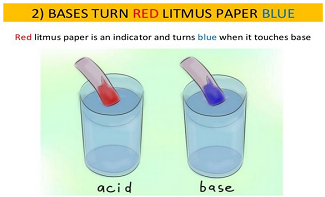
NCERT Solutions for Class 7 Science Chapter 5
This page consists of details of NCERT Solutions Class 7 Science Chapter 5. You can check NCERT Solutions Class 7 Science for other chapters prepared by Physics Wallah. Do the questions by yourself and check your solution with Physics Wallah NCERT solution for the chapter Acids, Bases and Salts.
To have more depth in the chapter Acids, Bases and Salts class 7 science you must read the theory of Acids, Bases and Salts and do the additional question of Physics Wallah click this link to do the questions and read the theory of Acids, Bases and Salts. along with the NCERT solution of class 7 science. NCERT Solutions Class 7 Science Chapter 5 questions are designed in a way to help you understand the chapter better.
NCERT Solutions for Class 7 Science Chapter 5 Nutrition in Plants Overview
It is essential for students to develop a sense of understanding in whatever chapter they are reading. The NCERT Solutions Class 7 Science chapter 5 addresses all the important topics. To completely grasp the concepts presented in this chapter and make appropriate use of the given solutions, students are advised to thoroughly read through each topic. To help with comprehension of the concepts in this chapter, Physics Wallah's instructors have created these solutions. The intention is for students to be able to successfully complete tests after reviewing and practicing these solutions.NCERT Solutions for Class 7 Science Chapter 5 Nutrition in Plants
While solving science specifically for class 7 you need lots of resources to excel in class 7 science to give you an edge Physics Wallah uploaded additional questions of class 7 science for a solid foundation of class 7 science, Academic team of Physics Wallah uploaded detail theory of class 7 science with added additional Notes & Questions.
Below we have provided the exercise of the NCERT Solutions Class 7 Science Chapter 5. Students can practice these questions and ace their preparation in this chapter. These NCERT Solutions Class 7 Science Chapter 5 will have you score better marks in your examination.| CBSE Syllabus Class 7 | |
| CBSE Class 7 English Syllabus | CBSE Class 7 Math Syllabus |
| CBSE Class 7 Social Science Syllabus | CBSE Class 7 Science Syllabus |
NCERT Solutions for Class 7 Science Chapter 5 Exercise 1
Question 1: State the differences between acids and bases.
Answer:
| - | Acids | Bases |
| (i) | These are sour to taste. | These are bitter to taste. |
| (ii) | Acids turn blue litmus red. | Bases do not change the colour of blue litmus. |
| (iii) | Acids do not change the colour of red litmus. | Bases turn red litmus blue. |
| (iv) | With china rose indicator, these give dark pink colour. | Bases give green colour with china rose indicator. |
| (v) | Acids do not change the colour of turmeric indicator. | Bases turn the colour of the turmeric indicator to red. |
Question 2: Ammonia is found in many household products, such as window cleaners. It turns red litmus blue. What is its nature?
Answer: Ammonia is basic as it turns the colour of red litmus paper to blue.

Question 3: Name the source from which litmus solution is obtained. What is the use of this solution?
Answer: Litmus solution is obtained from lichens. A natural dye extracted from lichens is dissolved in distilled water to obtain a litmus solution.
It is used as an indicator to distinguish between acids and bases.
|
Solution |
Colour of litmus solution |
|
Acidic |
Red |
|
Basic |
Blue |
|
Neutral |
No change |
Question 4: Is the distilled water acidic/basic/neutral? How would you verify it?
Answer: Distilled water is neutral. The same can be verified by using red and blue litmus papers. Neither will show a colour change with distilled water. This proves that distilled water is neutral.
Question 5: Describe the process of neutralization with the help of an example.
Answer: The reaction between an acid and a base is known as a neutralization reaction. In this reaction, both acid and base cancel each other’s effect. Neutralisation reaction results in the formation of salt and water. During this reaction, energy in the form of heat is evolved.
Acid + Base → Salt + Water + Heat
For example, when sodium hydroxide (NaOH) is added to hydrochloric acid (HCl), sodium chloride (NaCl) and water (H2O) are obtained.

Question 6: Mark ‘T’ if the statement is true and ‘F’ if it is false:
(i) Nitric acid turns red litmus blue. (T/F)
(ii) Sodium hydroxide turns blue litmus red. (T/F)
(iii) Sodium hydroxide and hydrochloric acid neutralise each other and form salt and water. (T/F)
(iv) An indicator is a substance which shows different colours in acidic and basic solutions. (T/F)
(v) Tooth decay is caused by the presence of a base. (T/F)
Answer:
(i) Nitric acid turns red litmus blue. (F)
(ii) Sodium hydroxide turns blue litmus red. (F)
(iii) Sodium hydroxide and hydrochloric acid neutralise each other and form salt and water. (T)
(iv) An indicator is a substance which shows different colours in acidic and basic solutions. (T)
(v) Tooth decay is caused by the presence of a base. (F)
Question 7: Dorji has a few bottles of soft drinks in his restaurant. But, unfortunately, these are not labelled. He has to serve the drinks on the demand of customers. One customer wants an acidic drink, another wants a basic and the third one wants a neutral drink. How will Dorji decide which drink is to be served to whom?
Answer: Since the drinks are edible, Dorji can decide by tasting the drinks. Acidic drinks will be sour to taste whereas basic drinks will be bitter to taste and neutral drinks will have no taste. If Dorji has a litmus indicator (solution or paper), then he can take its help. He should put one drop of each drink on blue litmus paper. If the colour of the litmus paper changes to red, then it is an acidic drink. Out of the remaining drinks, some are basic and some are neutral.
Again, he should put one drop of the remaining drinks on red litmus paper. If the colour changes to blue, then it is basic and the others are neutral. In this way, he can serve all three customers their respective drinks.
Question 8: Explain why:
(a) An antacid tablet is taken when you suffer from acidity.
(b) Calamine solution is applied on the skin when an ant bites.
(c) Factory waste is neutralised before being it into the water bodies.
Answer: (a) This is because during acidity, an excess of acids is produced in the stomach. An antacid contains a base, such as milk of magnesia. These bases react with excess acids and neutralize their effect, thus giving us relief.
(b) When an ant bites, it injects formic acid into the skin. Calamine solution contains basic zinc carbonate. Therefore, it is applied on the skin to neutralize the effect of formic acid.
(c) Factory wastes contain acids. Therefore, these wastes, when thrown directly into water bodies, harm aquatic lives. Hence, these wastes are neutralised with basic chemicals before being disposed of in water bodies.
Question 9: Three liquids are given to you. One is hydrochloric acid, another is sodium hydroxide and the third is a sugar solution. How will you identify them? You have only a turmeric indicator.
Answer: We will put a drop of each of the hydrochloric acid, sodium hydroxide, and sugar solution on the turmeric indicator. The liquid which changes the colour of the turmeric indicator to red is basic, that is, sodium hydroxide.
![]()
Now, we will put a drop of sodium hydroxide on a drop of each of the other two liquids separately. After that, we will put the drops of these mixtures on the turmeric indicator. The drop which will change the colour of the turmeric indicator to red contains a sugar solution. This is because the mixture of basic and neutral solutions is basic.
On the other hand, the drop which will not change the colour of the turmeric indicator contains hydrochloric acid. This is because hydrochloric acid reacts with sodium hydroxide to form a neutral solution.

Question 10: Blue litmus paper is dipped in a solution. It remains blue. What is the nature of the solution? Explain.
Answer: We know that basic and neutral solutions do not change the colour of blue litmus paper. Since blue litmus remains blue after dipping in the solution, the solution is either basic or neutral.
Put a drop of this solution on a red litmus paper. If it turns blue, then the above solution is basic and if no colour change occurs, then it is neutral.
Question 11: Consider the following statements:
(a) Both acids and bases change the colour of all indicators.
(b) If an indicator gives a colour change with an acid, it does not give a change with a base.
(c) If an indicator changes colour with a base, it does not change colour with an acid.
(d) Change of colour in an acid and a base depends on the type of the indicator.
Which of these statements are correct?
(i) All four (ii) a and d (iii) b and c (iv) only d
Answer: (iv) Only d is correct.
NCERT Solutions Class 7 Science Chapter 5 FAQs
What are the 5 acids and bases?
What is the name of Chapter 5 Science Class 7?
How do you test for acid bases Class 7?
What are the 2 types of bases?
What is the full form of pH?









